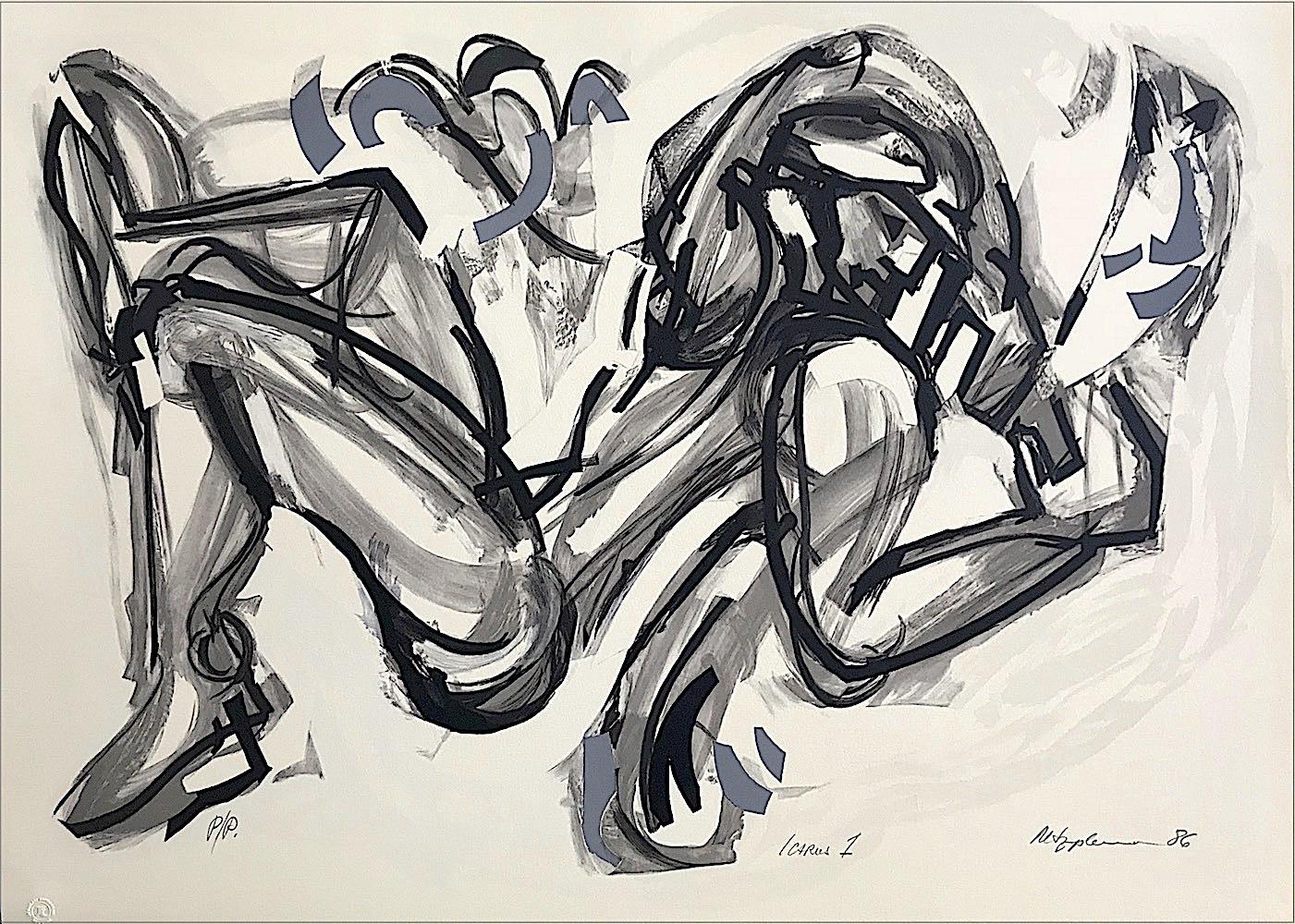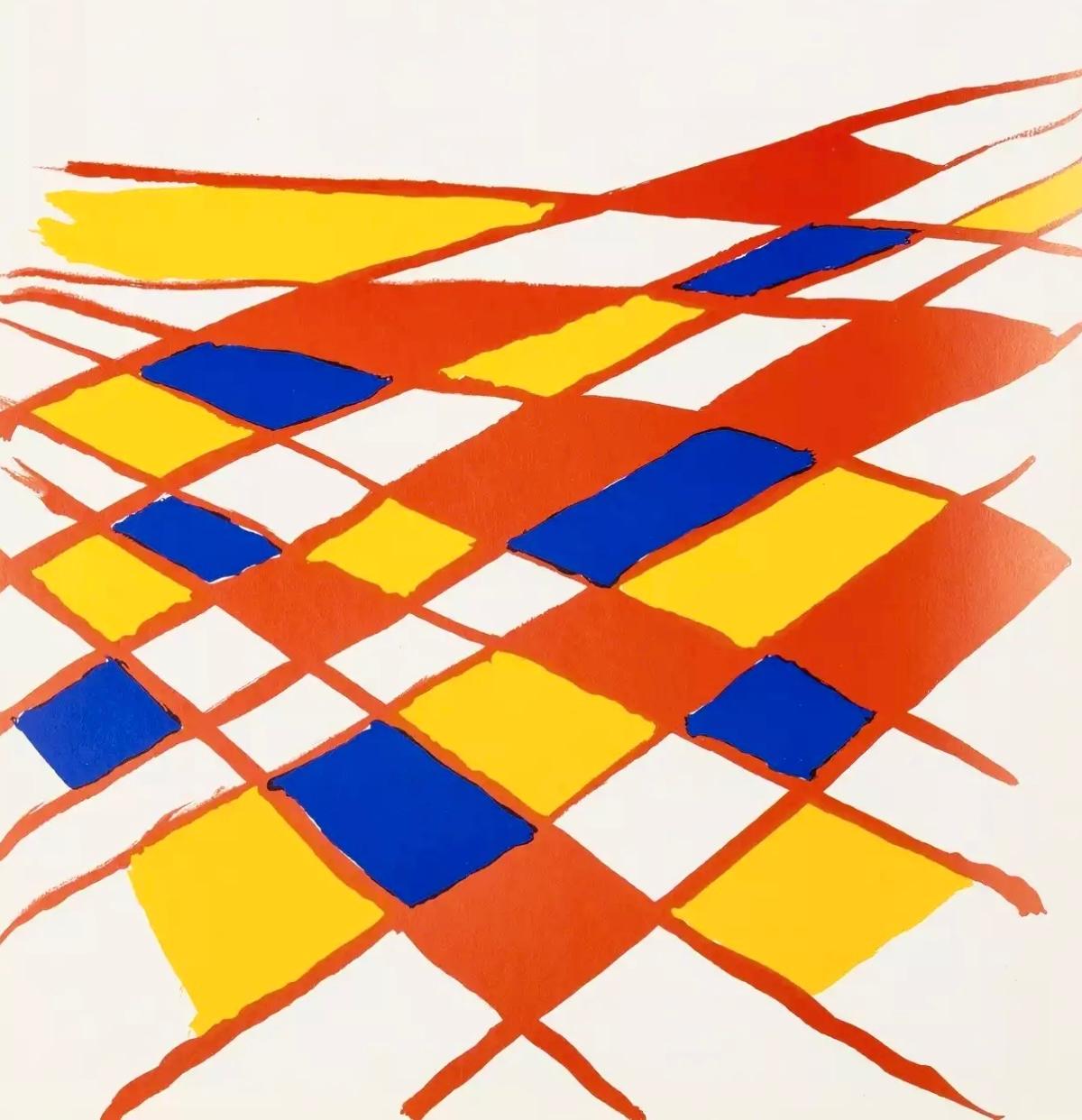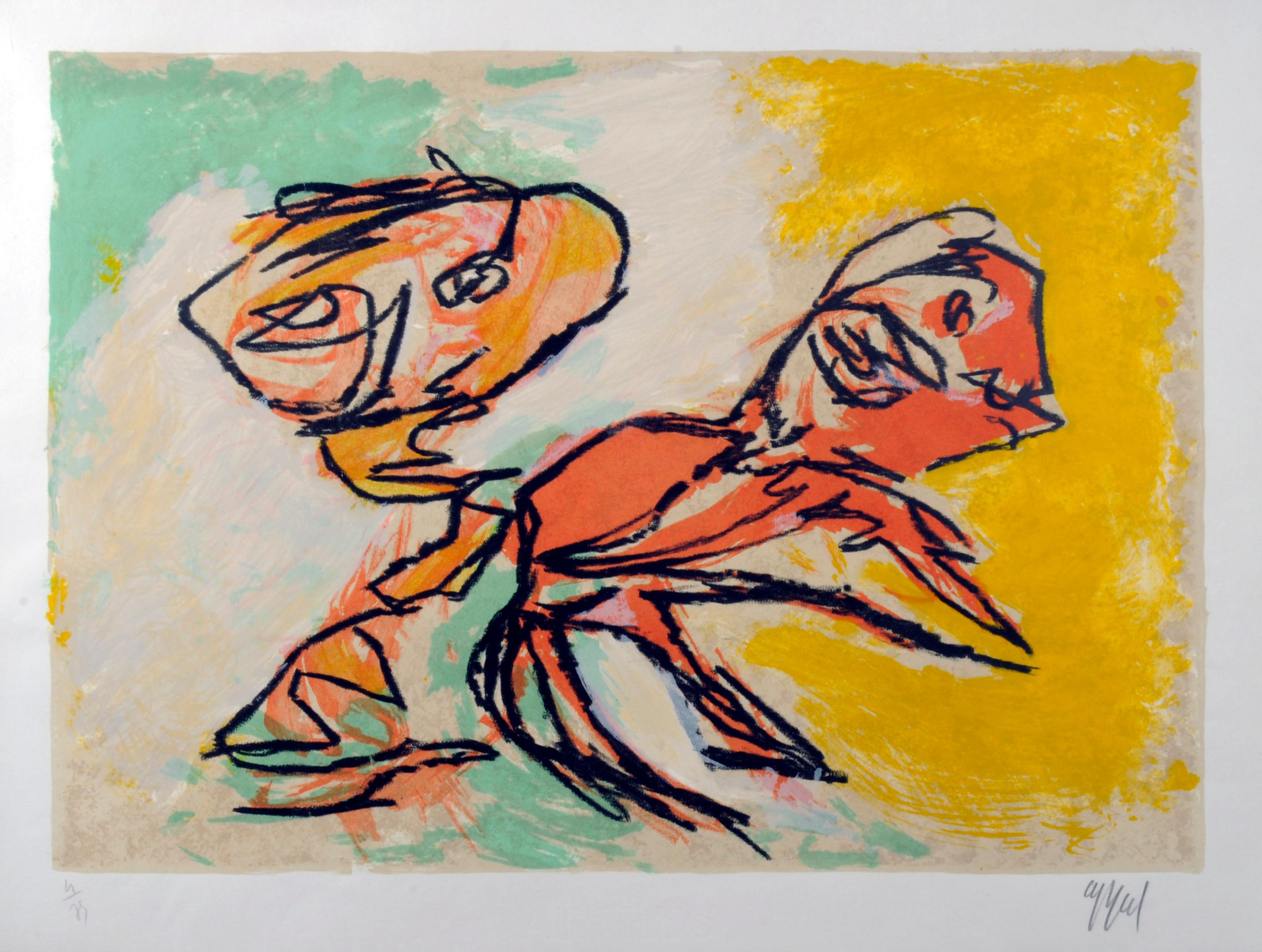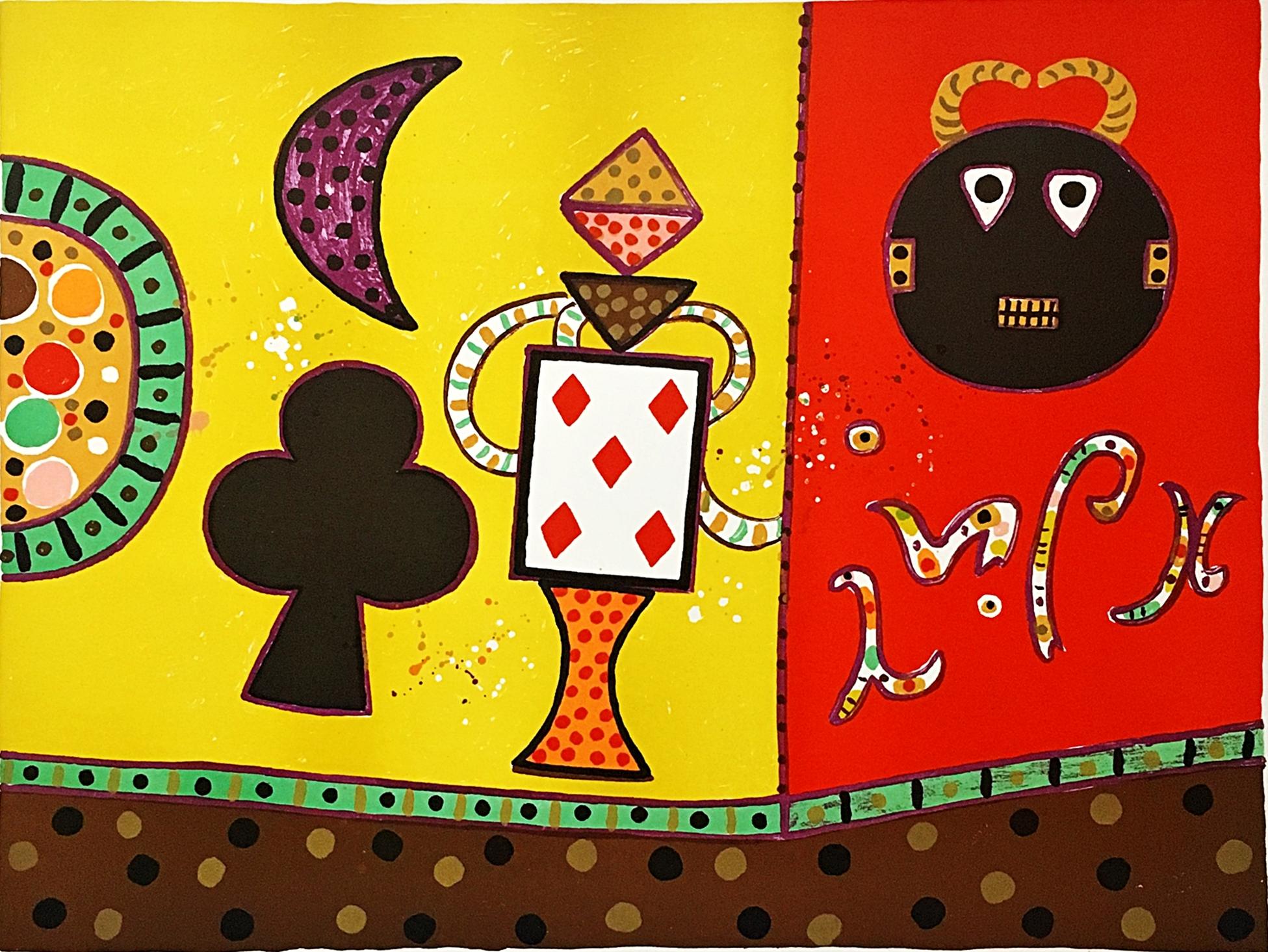Items Similar to Gold Leafed Bronze Wings
Want more images or videos?
Request additional images or videos from the seller
1 of 11
Lynda BenglisGold Leafed Bronze Wings1979
1979
About the Item
Lynda Benglis
Gold Leafed Bronze Wings, 1979
Lithograph on wove paper
Hand signed, dated 1979 and numbered by Lynda Benglis on the front in bright green crayon. Bears publishers blind stamp
Unframed and affixed to dark grey/black matting
Hand signed, dated 1979 and numbered by Lynda Benglis on the front in bright green crayon. Bears publishers blind stamp. Published by Landfall Press; a rare limited edition print from the 1970s, depicting a sculptural installation by one of the most dynamic influential and important art world superstars of our time.
The writing on the print:
Gold Leafed Bronze Wings
Black Concrete Obelisk
North South East West Elevation
Measurements:
Matting:
26.5 x 34 inches
Print:
22.5 x 30 inches
About Lynda Benglis:
Since the 1960s, Lynda Benglis has been celebrated for her free, ecstatic forms, which are simultaneously playful and visceral, organic and, abstract.
Benglis began her career in the midst of the Postminimal movement, pushing the traditions of painting and sculpture into new territories. She initiated several bodies of work in the late 60s and early 70s that set the course for her subsequent practice. Her wax paintings, which began with brushed skin-like layers of pigmented beeswax and dammar resin progressed, in one series, to the use of a blowtorch as a kind of brush, manipulating colors into a marbleized surface that seemingly fought against the constraints of the lozenge-shaped Masonite panels. The impulse to see these forms flow beyond the structure of a traditional support led Benglis to embrace pigmented latex, which she began pouring directly onto the floor. The use of gravity and her body in the latex pours invoked Jackson Pollock’s process, a connection immortalized in the February 27, 1970 edition of Life magazine, which featured Benglis at work.
Concurrently, she began working with pigmented polyurethane foam, building the volume of her sculptures vertically by pouring the oozing, lava-like forms against walls and in the corners of spaces or over constructed armatures and chicken wire, which she removed after the wall mounted foam pours solidified. Benglis’s totem-like sculptures followed as long, cylindrical structures made of wire mesh, cotton bunting, and plaster that, by 1972, she began to tie into knots. Painted with metallic sparkle, Sculp-Metal, or layers of sprayed, vaporized aluminum, copper, zinc, or tin, the works are further complicated by the reflections of their surfaces, conflating the sculptural object with painterly space. The contorted shapes, formed by the artist’s hands, express the bodily force used by Benglis throughout her career continuing with her gold sculptures of the late 1970s and early 1980s.
In the early 70s, Benglis took new media technologies as her material, producing video art at a time when it was still in its early stages as a medium. Her experimental videos feature performative actions and technological mediation to explore themes of physical presence, narcissism, sexuality, and gendered identity. Physical and Psychological Moments in Time, a retrospective of video works by Benglis, was held in 1975 by Fine Arts Center Gallery, State University of New York College at Oneonta, and subsequently traveled to Stedelijk Van Abbemuseum, Eindhoven, Netherlands. Benglis also introduced images of herself into the public discourse through a 1974 Artforum ad, which challenged assumptions about self-presentation and gender in the male-dominated art world.
Benglis extended her innovative use of materials into the natural realm when, in 1984, she first used water as an element in her sculptures. She won the competition to create a fountain for that year’s Louisiana World Exposition in New Orleans, resulting in The Wave of the World (1983–84) in cast bronze. Since then, she created numerous sculptural fountains, including Chimera (1988) and Double Fountain, Mother and Child, For Anand (2007), the latter originally installed at Le Jardin Botanique de Dijon, France, and North South East West (2009), which was initially exhibited at the Irish Museum of Modern Art, Dublin. These works effectively convey fluidity in both physical and thematic forms through the use of water as a medium.
The embrace of flowing forms, color, and sensual surfaces plays a large part in Benglis’s continuous investigation of the proprioceptive, sensory experiences of making and viewing her sculptures. From the complex chromatic harmonies of the wax paintings to the selected use of brilliant Day-Glo pigments or phosphorescence in her latex and foam sculptures, Benglis’s exuberant engagement with color, along with her radical employment of material, sets her apart from the more achromatic focus of her Minimalist and Postminimal contemporaries.
Courtesy of Pace Gallery
- Creator:Lynda Benglis (1941, American)
- Creation Year:1979
- Dimensions:Height: 26.5 in (67.31 cm)Width: 34 in (86.36 cm)
- Medium:
- Movement & Style:
- Period:
- Condition:In very good vintage condition; it is affixed to matting and ready for re-framing.
- Gallery Location:New York, NY
- Reference Number:1stDibs: LU1745213057192
About the Seller
5.0
Platinum Seller
These expertly vetted sellers are 1stDibs' most experienced sellers and are rated highest by our customers.
Established in 2007
1stDibs seller since 2022
303 sales on 1stDibs
Typical response time: 1 hour
- ShippingRetrieving quote...Ships From: New York, NY
- Return PolicyA return for this item may be initiated within 1 day of delivery.
More From This SellerView All
- Guli Wall, rare 1970s lithograph by famed British Pop artist Alan Davie Signed/NBy Alan DavieLocated in New York, NYAlan Davie Guli Wall, 1971 Lithograph on Rives BFK Paper with Deckled Edges Hand signed, numbered 26/200 and dated on the lower front 20 × 25 1/2 inches Unframed This whimsical mid-century modern hand signed, dated and numbered print by renowned Scottish-born British Pop artist Alan Davie published in 1971 was chosen to be included in the 1975 portfolio for the Swiss Society for Fine Arts (Grafikmappe des Schweizerischen Kunstvereins) as part of an international portfolio of 27 prints by world renowned artists. Hand signed and numbered from the edition of 200. Unframed and in fine condition. This vintage European print...Category
1970s Abstract Abstract Prints
MaterialsLithograph, Pencil
- Untitled Figure signed numbered mixed media print from scarce European portfolioBy George McNeilLocated in New York, NYGeorge McNeil Untitled Figure, 1986 Lithograph on paper. Publisher's and Printer's Blind Stamps Hand-signed, numbered 78/84 and dated by the artist on the front with publisher's and...Category
1980s Abstract Expressionist Figurative Prints
MaterialsLithograph, Pencil, Screen
- Westermann and Kapsalis Sculpture at Four Fourteen Art Center PosterBy HC WestermannLocated in New York, NYH.C. Westermann, Thomas Kapsalis Rare artist designed early poster: Westermann and Kapsalis Sculpture at Four Fourteen Art Center and Gallery Chicago, 1957 Historic offset lithograph poster designed by both artists Not signed 17 × 22 inches Unframed This extremely rare poster on handmade paper was published for the Tom Kapsalis/H.C. Westermann sculpture exhibition at 414 Art Workshop and Gallery, Chicago Momentum, 1020 Art Center, Chicago in December 1957. The poster was hand designed by both artists, with each one designing his respective half for a cohesive whole, for an exhibition at a small, now defunct regional art center in the late fifties -- so it's not unreasonable to believe that there just aren't too many of these out there anymore. A must have for anyone seriously involved in the careers and legacies of each or both of these sculptors. About H.C. Westermann: American artist Horace Clifford Westermann (Los Angeles, 1922 – Danbury, 1981) assembled a distinctive and singular body of sculptures. His works were predominantly made from wood through his masterly command of carpentry and cabinetmaking, yet he also used other techniques and materials such as metal, glass and enamelling with incredible precision. Without adhering to one particular style, Westermann was a maker of objects, of separate pieces: his sculptures, laden with meaning, often irony, result from the processing of experience, coalescing to yield specific fragments of reality. It is the course of these fragments that the retrospective presented by the Museo Reina Sofía follows. A concern with going back to shelter would soon emerge, be it in the home or the body —and blighted by the threat of confinement and death. Also, stubborn or helpless figures would recur through Westermann’s oeuvre. The motif of the “death ship” runs right through the breadth of his production as well, pointing, on one side, to continued wandering and latent abandonment and, on the other, to a determined pursue of refuge which seems to hold firm across his work. At the turning point of the 1960s, Westermann’s sculptures drew from mass culture, and made part of several exhibitions of the new realisms, when the “cold” tag of Pop art had not yet fully taken shape. The exhibition presents this output and the “specificity” of Westermann’s objects, which interested Donald Judd in 1963. In later pieces his work increasingly deals with the absurd, either through playfulness with language, in the confusion between work and instrument, or with references to the impermanent Besides the sculptures, the show displays Westermann’s paintings, letter-drawings —in his correspondence with other artists, critics and friends— and series of prints, in which he applied vibrant colours to address themes such as an escapist, while critical depiction of the American scene; catastrophe, and fragility. A graduate from the School of the Art Institute of Chicago in 1954, Horace Clifford Westermann produced most of his work from a small town in Connecticut, where he settled in 1961. He regularly exhibited his work in New York, and occasionally in Chicago and on the West Coast. Courtesy of Venus Over Manhattan About Tom Kapsalis: One of Chicago’s great abstractionists, painter Thomas H. Kapsalis (born 1922) has been an important artist and educator since the late ’40s, when he graduated from the School of the Art Institute. A prisoner of war in Germany, captured during the Battle of the Bulge, Kapsalis returned to continue his pursuit of art-making, eventually returning to Germany in the early ’50s on a Fullbright-Hays Fellowship to study with Willi Baumeister. He has taught at the School of the Art Institute since 1954, and his work has been exhibited in numerous group and solo shows. Among the honors bestowed upon Kapsalis are Huntington Harford Foundation Grants (1956, 1959); Robert Rice Jenkins Prize, Chicago & Vicinity Exhibition, Art Institute of Chicago (1956); Pauline Palmer Prize, Chicago & Vicinity Exhibition, AIC (1960); Mr. & Mrs. Julie F. Brower Prize, Chicago & Vicinity Exhibition, AIC (1969). Courtesy of Corbett vs...Category
1950s Abstract Abstract Prints
MaterialsLithograph, Offset
- de Kooning in East Hampton (Hand Signed), from Estate of Alan YorkBy Willem de KooningLocated in New York, NYWillem de Kooning de Kooning in East Hampton (Hand Signed), from Estate of Alan York, 1978 Offset lithograph poster (Hand signed by de Kooning) Boldly s...Category
1970s Abstract Expressionist Abstract Prints
MaterialsOffset, Permanent Marker, Lithograph
- Historic lithograph (Hand signed by Sol Lewitt, Philip Glass and Meredith Monk)By Sol LeWittLocated in New York, NYSol Lewitt Benefit Concert (Hand signed by Sol Lewitt, Philip Glass and Meredith Monk), 1978 Offset lithograph 19 1/2 × 21 1/2 inches Limited Edition of 75 Hand signed by Sol Lewitt ...Category
1970s Abstract Abstract Prints
MaterialsOffset, Pencil, Lithograph
- Adolph Gottlieb exhibition poster for Guild Hall in Easthampton, NY - FramedBy Adolph GottliebLocated in New York, NYAdolph Gottlieb Guild Hall is for Everyone, 1970 Vintage Offset Lithograph poster Vintage metal Frame included Rare vintage, limited edition, offset lithograph poster. Donated by D...Category
1970s Abstract Expressionist Abstract Prints
MaterialsLithograph, Offset
You May Also Like
- Bacon, Untitled, 1987 (after)By Francis BaconLocated in Fairfield, CTArtist: Francis Bacon (1909-1992) Title: Untitled Year: 1987 Medium: Offset Lithograph on premium paper Size: 26.25 x 19.75 inches Condition: Excellent Notes: Published by Galerie Le...Category
1980s Abstract Expressionist Abstract Prints
MaterialsLithograph, Offset
- ICARUS I Signed Lithograph, Abstract Male Figure, Collage, Greek MythologyBy Marius SznajdermanLocated in Union City, NJICARUS I is an original hand-drawn lithograph created in 1986 by the French American artist Marius Sznajderman, printed in neutral warm grays and intense black on archival Arches paper 100% acid free. ICARUS I is an expressionistic abstract male...Category
1980s Abstract Figurative Prints
MaterialsLithograph
- Alexander Calder lithograph derrière le miroirBy Alexander CalderLocated in NEW YORK, NYAlexander Calder Lithograph c. 1971 from Derrière le miroir: Lithograph in colors; 15 x 11 inches. Very good overall vintage condition; well-preseved. Unsigned from an edition of u...Category
1970s Abstract Abstract Prints
MaterialsLithograph, Offset
- Original "Monte-Carlo Festival International de Television" vintage posterLocated in Spokane, WAOriginal Monte Carlo Festival International de Television antique poster. Size: 25.5" x 36". Artist Molné (Molne). Year: 1963. (Monte Carlo...Category
1960s Abstract Impressionist Figurative Prints
MaterialsLithograph
- Sprong in de Lente (Deux Personnages)By Karel AppelLocated in Fairlawn, OHSprong in de Lente (Deux Personnages) Color lithograph, 1963 Signed, dated and numbered in pencil (see photos) Edition: 25 Signed, dated and numbered in pencil Printed on Arches paper Probably exhibited at David Anderson Gallery/Martha Jackson Gallery. Provenance: Martha Jackson Gallery David Anderson Gallery David K. Anderson Grandchildren Trust Condition: Colors fresh and unfaded Slight oil stains verso from the ink, not visible on front Image size: 18 1/2 x 26 inches Sheet: 22 x 29 5/8 inches Karel Appel B. 1921, AMSTERDAM; D. 2006, ZURICH Karel Appel was born on April 25, 1921, in Amsterdam. From 1940 to 1943 he studied at the Rijksakademie van Beeldende Kunsten, Amsterdam. In 1946 his first solo show was held at Het Beerenhuis, Groningen, Netherlands, and he participated in Jonge Schilders (Young painters) at the Stedelijk Museum, Amsterdam. About this time, Appel was influenced first by Pablo Picasso and Henri Matisse, then by Jean Dubuffet. He was a member of the Nederlandse Experimentele Groep (Dutch Experimental Group, 1948) and established the Cobra group (1948–51) with Constant (Constant Nieuwenhuys), Corneille (Guillaume Cornelis Beverloo), and other painters from Copenhagen, Brussels, and Amsterdam. The style distinguished itself through bold, expressive compositions inspired by folk and children's art, as well as by the work of Paul Klee and Joan Miró. In 1949 Appel completed a fresco for the cafeteria of the city hall in Amsterdam, which created such controversy that it was covered for ten years. In 1950 the artist moved to Paris; there the writer Hugo Claus...Category
1960s Abstract Abstract Prints
MaterialsLithograph
- Olympische Spiele Muenchen (The Runners) by Jacob LawrenceBy Jacob LawrenceLocated in Long Island City, NYArtist: Jacob Lawrence (1917 - 2000) Title: Olympische Spiele Muenchen (The Runners) Year: 1972 Medium: Lithograph Poster mounted on linen E...Category
1970s Abstract Expressionist Abstract Prints
MaterialsLithograph
Recently Viewed
View AllMore Ways To Browse
Wings Of The
Gold Wings
Vintage Bronze Wire
Bronze Knot
70s Bronze
French Bronze Element
Bronze Copper Marble
Prints With Chickens
Mother Child Bronze
Bronze Mother And Child
Large Bronze Male
60s Wall Sculpture
Ireland Lithographs
Wings Reflection
Marble Wings
Abstract Metal Wave Art
New Orleans Lithograph
Limited Edition Prints 1970s And 1980s




